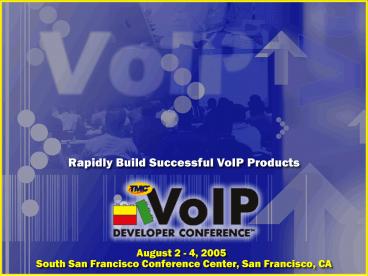Developing Cable Telephony Solutions - PowerPoint PPT Presentation
Title:
Developing Cable Telephony Solutions
Description:
VoIP over Cable is experiencing strong growth within North America ... firewalling subsystem. iptables. http://pptpclient.sourceforge.net/ VPN software. PPTP Client ... – PowerPoint PPT presentation
Number of Views:37
Avg rating:3.0/5.0
Title: Developing Cable Telephony Solutions
1
(No Transcript)
2
Developing Cable Telephony Solutions
Michael MetzgerExecutive Director,
MarketingMindspeed Technologies, Inc.
3
Agenda
- Introduction
- Voice over Cable Architectures
- Cable Standardization Bodies
- High Density Cable Gateway SoC Solutions
- EMTA SoC Solutions
- Whats Next in Voice over Cable?
4
Introduction
- VoIP over Cable is experiencing strong growth
within North America - Forecast of more than 17 M Voice over Cable
subscribers in 2008 - VoIP over Cable completes MSOs offering for
triple-play voice, video, and data services - Fundamental change in architectures moving to
Packet-based networks from analog Voice over
Cable
5
Voice over Cable Current Architecture
Headend
Class 5 Switch
Cable Modem
Network Interface Terminal
IP Network
- Analog voice traffic placed on cable medium, and
connected to PSTN using traditional Class-5 switch
6
Next Generation VoIP over Cable
CMTS
Data/Voice Traffic
IP Network
Call Mgmt Server
Voice Traffic
SBC
EMTA
IP Network
Media GW, Signaling GW
WiFi
- True VoIP over Cable, packetized in converged MTA
solutions - Migration to all IP networks
7
PacketCable
- Specification forum focused around detailing the
architecture for next-generation IP Cable
networks - For Voice, PacketCable details
- QoS
- Security
- PSTN IP Interconnect
- Lawful Intercept
- Reliability
8
IPCablecom Standardization Process
Global Standards (J.160 J.174)
ITU-T
Regional Standards
SCTE
TCC (Japan)
ETSI
Contributors
CableLabs (projects)
ECCA (requirements)
Vendor
Vendor
Vendor
9
PacketCable Timeline
- Rel 1.0
- Architectural framework for Packet-based Cable
networks (1999) - Rel. 1.5
- Added new voice codecs, fax relay (2005)
- Future Releases
- IMS architecture mobility
- Call control moving to SIP
- New voice and video codecs
10
PacketCable QoS
- Quality of Service in PacketCable networks must
at a minimum be equal to that of the PSTN - Fundamental requirement to drive adoption
- Major Factors affecting QoS for voice
- Voice Compression Technology
- Packet Loss
- Packet Latency/Delay
- Echo Cancellation
- To ensure high QoS, SoCs must address the above
11
Typical High-Density Gateway Solution
Control and Signaling
Media Stream Processing
Ethernet
Ethernet
Voice Channels
DSP Resource Manager
Control Applications
TDM
Signaling Stacks
N x DSP
Host Operating System
Internal Memory
Media Stream Processing sub-system offloads host
CPU
12
SoC Solutions for High Density Gateways
VoIP to TDM (with/without encryption)
Media Forking for CALEA (with/without encryption)
Transcoding (IP-IP) (with/without encryption)
13
SoC Architectures for High Density Gateways
14
DSP Functions Codecs
- Limited uplink speed demands complex voice codecs
- Echo Cancellation G.168-2002/4
- Required G.711, recommended G.729e, G.728 (Rel.
1.0) - Added required iLBC, BV-16 (Rel. 1.5)
- Future release
- Wide-Band Codecs
- Wireless Codecs
15
Example of Wireline/Wireless Codec SMV
- Selectable Mode Voice Codec (SMV) Standardized
for CDMA2000 - G.711 Equivalent Voice Quality
- Music Detection
- Efficient Rate Determination Algorithm Average
Bitrate 4kbit/s - 4 coding rates (full-rate8.5kb/s, half-rate
4.0kb/s, quarter-rate 2.0kb/s, eight-rate
0.8kb/s)
16
DSP Functions Intelligent Transcoding
- Increasing demand for Voice transcoding with
migration to an all IP network - Dynamic prediction algorithms prevent the
degradation of voice quality inherent in typical
G.711 transcoding schemes - Roundtrip delay critical for voice quality over
an IP network is significantly minimized - No echo cancellation required
17
Fax Modems Transport
- Required Packet DSP functions
- Transmit V.90 and 14.4 kbit/s FAX (over G.711)
- T.38 Fax Relay
- 40 ms frame sizes
- Packet redundancy
- Synchronization of end-points less than 0.25
frame slips per minute
18
Security Processing
- PSTN security is based around the assumption that
there is a direct dedicated link between the user
and the central office - In PacketCable networks, shared medium is used
- As such, cryptographic methods are used to
provide security in PacketCable for call privacy - Optional implementation
- 128-bit AES encryption
- MMH/SHA-1 for message authentication
19
Packet Cable Voice Payload Encryption
IP
UDP
Voice payload
Authentication
RTP
Encrypted Portion (AES)
Authenticated Portion (MMH)
20
5 x 9s Reliability with N1 Redundancy
21
Low to Medium Density MTAs
Embedded MTA
SoC
SHM
T S I
Control Signaling Processor
CSP
1 to N Telephones
Voice Data Routing
MSP
Telephony Interfaces
CablePHY
Voice DSP core
EXPANSION BUS
PCI
Wi-Fi
Printer or Peripheral
USB 2.0
MMU
Dual EMAC
Security
Ethernet
Memory
22
CSP MSP Model
- Deterministic Voice Quality Data Routing/VPN
Performance - MSP/CSP partitioning for real-time non
real-time processes - Corner case interoperability standards
compliance - CODECs common functions run on MSP
- New/3rd Party Applications does not affect MSP
Processing - CSP hosts applications independent of media
stream - E.g Linux or VxWorks
Single UnifiedMemory
Non Real-time
CSP Control Signaling Processor
DDRSDRAM
Virtual EthernetDriver
Real-time
MSP Media Stream Processor
Cable Modem
Ethernet
TDM
23
Open Source Applications for a CSP
Project Application Home
Linux Kernel 2.6 UNIX OS with integrated IPSec http//www.kernel.org/
Apache Web Server http//www.apache.org/
Busybox Common UNIX utilities http//www.busybox.net/
Asterisk PBX, IVR, voicemail http//www.asterisk.org/index.php?menufeatures
OpenH323 H.323 protocol http//www.openh323.org/
OpenSIP SIP user agent, proxy http//www.gnu.org/software/osip/osip.html
MGCP MGCP implementation http//www.vovida.org
Festival Lite Text-to-Speech engine http//www.speech.cs.cmu.edu/flite/
PPTP Client VPN software http//pptpclient.sourceforge.net/
iptables firewalling subsystem http//www.netfilter.org/
GNU Zebra Routing Protocol Manager http//www.zebra.org
gcc C/C Cross compiler http//gcc.gnu.org/
gdb Debugger http//sources.redhat.com/gdb/
Ethereal Network Sniffer (with MND plugin) http//www.ethereal.com/
KDevelop Flexible IDE http//www.kdevelop.org/
Telephony
Core
Networking
Development Tools
24
Whats Next in Voice over Cable?
- Mobility
- Support cellular handset/WLAN
- Wireless/Wireline Transcoding in Cable GW
- Call control mechanisms
- TGCP ? SIP
- Migration to IP V6
- Integration of Session Border Controllers
functions into Cable GW - Adoption of IMS Architecture
- Instant messaging (IM)































